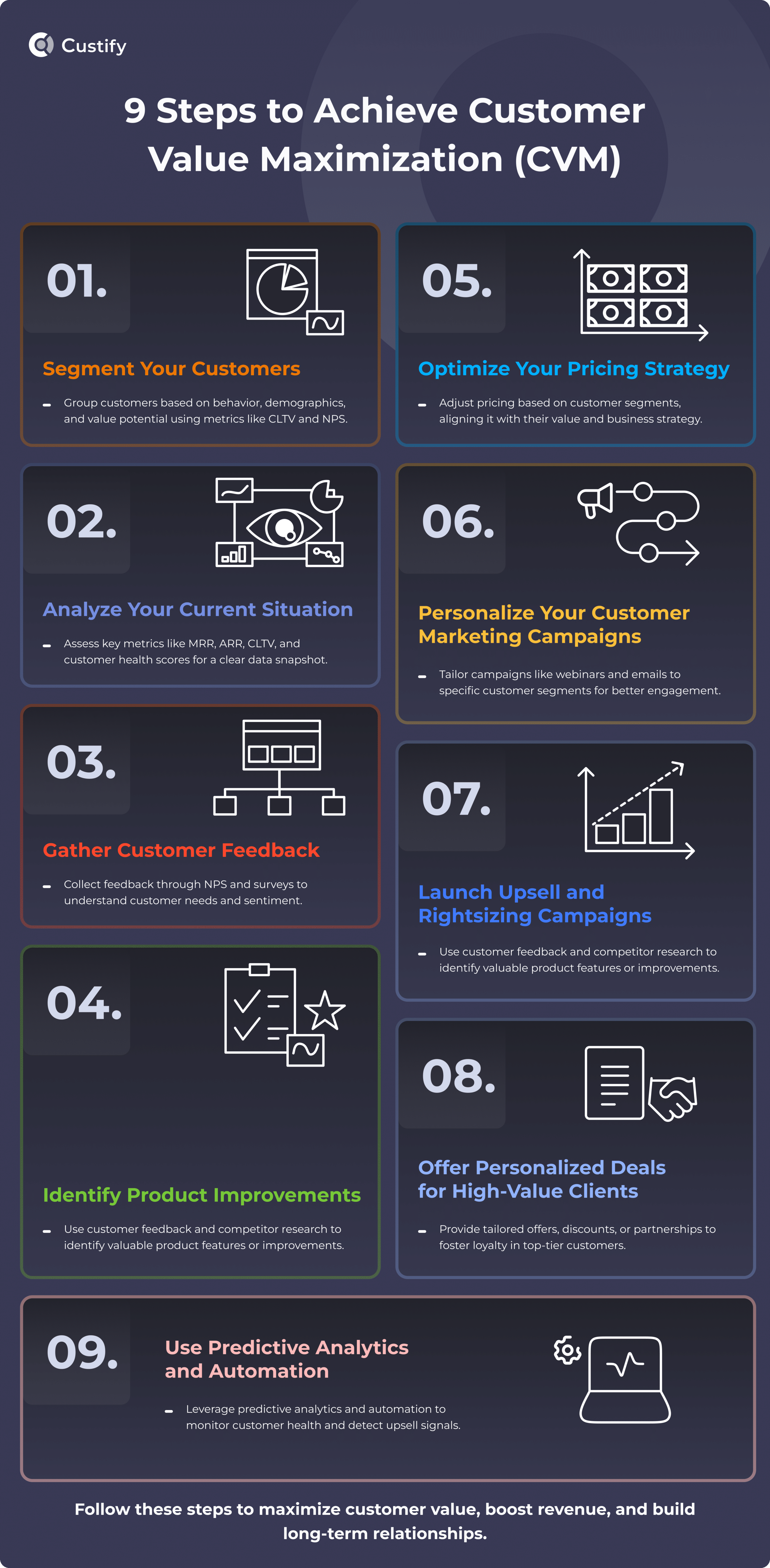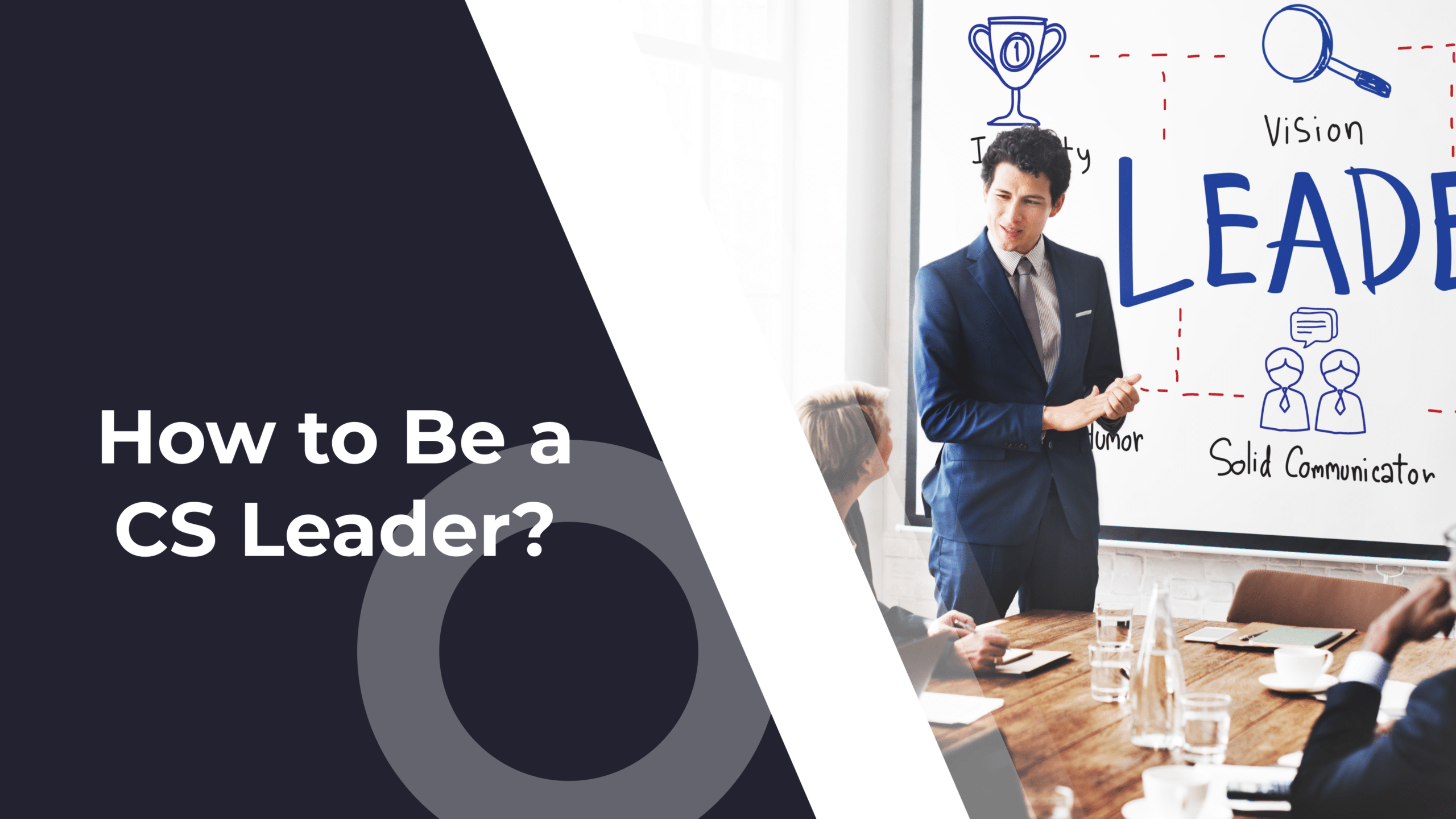Customer success has always had a complex identity crisis. Let me explain:
93.7% of companies measure CS impact using revenue targets*. Yet, over 83% of CS leaders say their biggest challenge is delivering value to customers.
See the disconnect? The issue is there often doesn’t seem to be a consensus that both revenue and customer value are intrinsically tied. As is the core principle of CS – successful customers stay with you longer, spend more than new customers, and bring in additional business.
The solution? Customer value maximization, which is the practice of maximizing customer value by providing value to them through a consistent set of CS practices. Today, I’ll walk you through an in-depth guide to CVM and how to implement it in your organization.
*Data from Daphne Costa-Lopes’s Customer Success Trends 2024 Report.
What Is Customer Value Maximization?
Customer value maximization is a business concept that implies drawing as much value as possible from your existing customer base so as to garner high returns as quickly as possible. It has its roots in the Global Financial Crisis of 07/08 when banks needed viable paths to recovery. However, over time, CVM has become a broader concept due to its widespread and somewhat casual adoption. Today, CVM can be a great tactic to recover business revenue, if implemented correctly.
Why do you need it? Well, consider these stats:
- Gartner Group states that 80% of a company’s future revenue will come from just 20% of its existing customers.
- According to Bain and Company, a 5% increase in customer retention will increase a company’s profitability by 75%.
At the same time, customer value as a standalone term today is being used interchangeably, particularly in customer success, to mean both the value customers bring to a company (i.e. revenue) and the value being provided to customers by the company. This has, unfortunately, led to a good deal of confusion, especially between the tactics employed (amplified by the fact that most are often used together).
So, how can we clear up the confusion? Let’s start with an example:
What is an example of value maximization?
Say you’re the lead CSM of a SaaS platform. Your business isn’t doing too well – your customers are happy and loyal thanks to your brilliant work, but they’re not bringing in enough revenue to keep your company afloat. So, during your next company strategy meeting, the CEO turns to you and says “let’s try maximizing our customer value.” What can you do?
A simple tactic that can grant immediate returns and calm everyone down comes in the form of upsells. Simply determine which service add-ons or upgrades could serve your top-performing accounts well and then reach out in an emotionally intelligent manner that takes into consideration account specifics and capitalizes on opportunities. But this is just the start!

Source: chaotic-flow.com
Also, check out a practical case study on how Sitejabber achieved an 80% retention and a 25% upsell revenue increase using Custify to implement customer value maximization.
Can you maximize customer satisfaction by adding value strategically?
Yes, you can.
CVM shouldn’t mean throwing customer experience out the window and charging customers for features they’re used to for free. Particularly in today’s market that’s oversaturated with subscription services, you should be deeply aware of subscription fatigue and how poorly thought-out business practices can contribute to it and actively lead to both revenue and customer churn.
Instead, it’s recommended to add value while attempting to get value. So keep a close eye on your CSAT as you make changes that will result in more revenue. If CSAT or other health scores start going down, you can strategically add value to raise them back up. Remember – it’s always going to be a tug of war to achieve the perfect formula.
What’s the difference between CVM and CRM?
CRM today is used to mean “CRM platform.” But the idea of customer relationship management is somewhat distinct. It has its roots in the Paleolithic as, even back then, it was much more profitable to trade with an existing customer base than it was to find a new one (far more costly than today, I’d argue).
The modern concept of Customer Relationship Management was developed between the 60s and 90s by contributions from diverse sets of companies and individuals, the most significant of which were those of Robert and Kate Kestnbaum, and Robert Shaw who together developed the marketing methodologies behind CRM (including customer lifetime value and marketing channels).
To sum up the difference between CVM and CRM, the first has to deal more with optimizing value (aka revenue), while the second is more about managing relationships to promote customer retention and loyalty. Both approaches can lead to similar growth and can even work in tandem. Let’s explore the differences side-by-side:
| Customer Value Maximization (CVM) | Customer Relationship Management (CRM) | |
| Point of View | Revenue Growth | Relationship Building |
| Coined | 2007-2008 | 1960-1990 |
| Focus | Short-term returns and recovery | Customer lifetime value |
| Key Tactics | Upselling, Cross-selling, Feature additions, Rightsizing, Customer Marketing | Onboarding Optimization, Customer Engagement, Churn Prevention, Winback |
| Common KPIs | MRR, ARR, LTV, LTV:CAC, CRC, Feature Adoption Rate, Product Usage, Account Growth, NPS, Referrals | GRR, NRR, CRC, Retention Rate, Churn Rate, Customer Health Scores, Customer Relationship Length, CSAT |
| Teams Responsible | Customer Success, Sales, Marketing | Customer Success, Customer Support |
How Do You Achieve Customer Value Maximization?
Now that all the theory’s out of the way, how do you actually practice CVM in a strategic way? To be effective, your CVM playbook needs to be:
- Data-backed
- Easy to understand
- Easy to communicate
- Easy to implement
- Cost-effective
- Scalable

To that end:
1. Start by analyzing your current situation
The first step is to look at your data. Make sure you have a good tracking setup for MRR, ARR, the payback period for newly-acquired customers, and other relevant metrics for your client base. Your goal is to paint an accurate, data-driven snapshot of where you are right now.
Other tactics / technologies you can use to make this step more efficient:
- Customer segmentation
- Health score clustering
- Automation flows and AI
- Voice of the Customer initiatives
- Gap Analyses
2. Look for possible product improvements, features, and add-ons
Once you’ve completed this snapshot of your current predicament, start looking over the fence to your competitors and attempt to answer two questions:
- What are they doing that customers love?
- What aren’t they doing that customers need?
For help with this research, look for low ratings on platforms like G2 or GetApp.
Once done, pair your results with features requested by your customers and prioritize. You should obtain a set of features that customers would value and would be willing to spend money on (either as an add-on or as a higher subscription plan).
Remember: check in with Product throughout the process to make sure you’re not wasting time on features that could never be implemented.
3. Attempt to switch up your pricing strategy or model
A simple shift in the way you charge for your services could maximize customer value and save your business. You have to create a pricing model for the new features we were mentioning anyway, so why not look at the business as a whole? 😉
You’d be surprised how often the pricing strategy or model simply does not fit the business offer. According to Hanover Research, 47% of new products fail due to pricing so there’s almost a 50/50 chance you haven’t reached your ideal pricing model yet.
Here are some common pricing mistakes:
- Disconnects between pricing and business strategy
- Going with your gut feeling (even based on industry experience)
- Not matching your price to customer segments
- Mismatch between your desired price and what your target can afford
- Relying entirely on the cost of production
- Setting a price without appropriate market and competitive research
If you think you’re guilty of one or more of the above, maybe you should be thinking of a pricing change? I put together a cheat sheet of pricing models and strategies to help you out.
4. Coordinate and support a customer marketing campaign
Customer marketing can be incredibly useful, particularly if paired with a new feature launch and with data and leadership from the customer success team.
To do this right, use the behavioral and customer health data you’ve gathered during point 1 to create a marketing strategy. Take into account customer sentiment, feature synergy, and how you can promote complementary features next to each other. Tactics for customer marketing include:
- Webinars
- Case studies
- Educational materials
- Customer emails
Of course, such a campaign can be supported by the next tactic:
5. Launch an upsell and rightsizing push for your top customers
Using the data you gained, you can task fellow CSMs with going to your top customers (based on customer health score) and attempting an upsell campaign.
The goal is to upgrade their subscriptions, either through new feature add-ons or to higher tiers. This process will kickstart your revenue engine if done right – such as by using health scoring to measure customer sentiment and determine the best upselling and cross-selling opportunities.
A different kind of upsell can be achieved through rightsizing – i.e. by reviewing your accounts and checking if they’re on a lower subscription level than they would realistically need.
Upselling through rightsizing is one of the rare cases where the “logins” health score can be very useful. Think of it this way: customers who log in a lot are either experiencing bugs (which still need fixing) or are sharing their accounts with multiple team members instead of paying for extra users.
The right approach after identifying these accounts is to check in with them and see why they’re not upgrading. If they didn’t know, you can upsell them right then and there. If they can’t afford the higher plan, consider the next point on the list.

6. Prepare and make personalized offers for dream or whale customers
Sometimes, customers that fit your ICP really well (“dream clients”) or those that bring in A LOT of revenue (“whale clients”) can’t really afford to upgrade their subscriptions. However, they already have one of the highest MRRs in your customer base – so what can you do? Easy – make exceptions like:
- Striking a co-marketing deal and offering a discount.
- Turning the relationship into a partnership and offering a discount.
- Simply offering a limited-time discount.
- Giving them a free 1-month trial of the new subscription tier.
- Figuring out a different type of partnership that may work for both parties.
It’s all up to you, what makes sense for your organization, and how you can balance that ROI. It’s also part of what turns a Head of CS from good to great – the ability to think strategically about customer relationships and value maximization.
7. Be proactive and use predictive analytics
So you went through this entire process of customer value maximization, and now you can sit back and relax. Just joking – if you know anything about anything in customer success, you know that never happens.
Your perfect CVM setup won’t mean a thing if you have to manually repeat the process every time. Instead, turn it into a continuous process by looking to:
- Monitor those initial datapoints in your CSP dashboard and analytics
- Set up a scalable customer feedback and voice of the customer workflow
- Align and collaborate with other teams in your organization
- Identify common signs of upsell opportunities
- Set up automation flows and health score signals based on those signs
- Predict customer behavior at scale based on segments, clusters, and more
All these practices and more can turn your CS team into a well-oiled engine that maximizes customer value.
What Can Companies Do to Enable Customer Value Maximization?
If you want an effective CVM process, it should never be the responsibility of customer success alone. Leadership must ensure that they’re primed to deliver the best possible results. To do that, the should:
- Enable Customer Success to Handle CVM. That means shifting focus to CVM, allowing for increased budgets (if necessary), or reducing workload from other areas.
- Set Intelligent OKRs for Customer Success. While the CS OKRs are typically the responsibility of the CS leader, other C-level functions usually have some input. To effectively drive CVM, there should be at least one OKR tied to it, such as “Grow MRR by 10%.”
- Foster an Environment Based on Trust and Collaboration. Last but definitely not least, leadership should ensure CSMs feel free to propose novel tactics and strategies that can enable CVM.

Above, you can see the top 4 CSM challenges according to our latest CSM Insights report. In order for customer value maximization to work effectively in your organization, these complaints (at the very least) need to be resolved.
Summing Up
Through all these practices combined, customer value maximization can thrive and bring your business back onto stable ground.
CVM can be a great tactic to use both for recovery during difficult times and for moments when you simply want to achieve healthy and sustainable growth.
Are you thinking of implementing CVM? Our team of expert CSMs stand ready to assist you with implementation.




